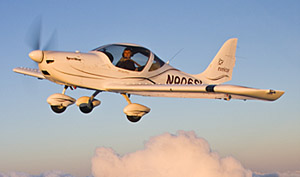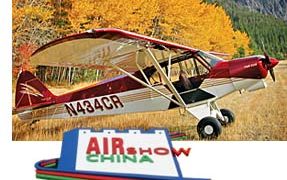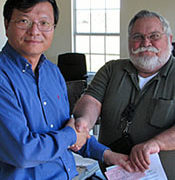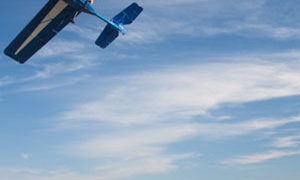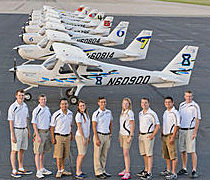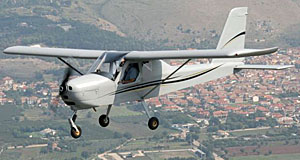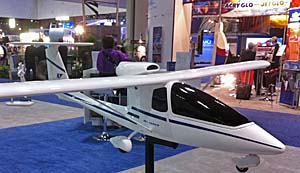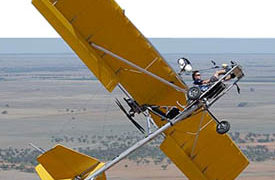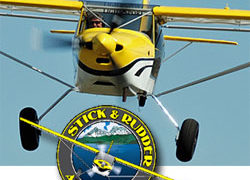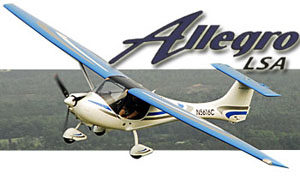On November 30th, Guy Reynolds will celebrate his 100th birthday by taking a flight in Light-Sport Aircraft. Putting a finer point on it, he’ll take this flight in his LSA. Are you surprised that a centenarian has an LSA? Admit it… I was. However, Guy is no ordinary guy. He bought his Evektor Sportstar back at the beginning of LSA and he’s been flying it about 100 hours every year. That’s probably more than you fly your LSA. Impressive even for a young 50-year old pilot, this fact is, well… astounding for a 90-something pilot.
Before you question the wisdom of this flight, let me assure you Guy is a pretty together fellow. We spoke on the phone and other than being a bit hard of hearing, he sounded great. I accept that he’s 99+ because he said so but he sounds like a younger person. He was savvy enough to voluntarily give up flying with anyone other than another pilot at age 95 because, “I might have a stroke or something and don’t want to endanger anyone.” So, quit your worrying.
Mid-November 2012 LSA News Wrap
Good to Go in China Things are happening in China. “So, what’s new,” you say? “We’ve been hearing about China for months.” Things may move slowly in China but this week, Airshow China is happening in the southern city of Zhuhai and my colleague, Jan Fridrich is present. He reports that some LSA are displayed including Triton’s Mermaid and SC3D (based on the SportCruiser), Flight Design’s CTSW, Colyaer’s Freedom, and some other aircraft he is working to identify. Watch for a followup article. Triton is the new China-based factory run by Chip Erwin. ••• LSA leader CubCrafters gained Type Certificate approval in China for their Part 23-certified Top Cub. General Manager Randy Lervold said they have taken no steps with the LSA models but that they expect to pursue that in the future. Meanwhile, though the company announced the sale of two Carbon Cubs in Europe, they are taking a similarly measured approach using Permit to Fly privileges for now.
SeaRey Passes FAA Audit, Becomes SLSA #129
Consider this an entry to the “They-said-it-couldn’t-be-done” department. As regular readers know, FAA has been conducting audits with LSA producers… tough, top-to-bottom reviews of every detail in the voluminous ASTM standard set. Last April another company had no less than six FAA personnel in their building for three full days, each armed with a laptop and literally hundreds of questions. Passing one of these grueling tests is a fairly major accomplishment. Then consider FAA amped up the task by saying any new model or first LSA from a new company would probably get one of these thorough inspections before they could enter the market. Progressive Aerodyne hosted such an FAA team to examine their first SLSA candidate and — surprise! — they came out with a certificate. No followup is needed.
So the heartiest of congratulations go to Progressive Aerodyne and their SeaRey. Yesterday they were issued their airworthiness certificate after a visit from five FAA personnel from both Washington, DC and the local Orlando, Florida MIDO (Manufacturing Inspection District Office).
Quicksilver Adds Five Aircraft to FAA Kit List
Last Spring I had the pleasure of photographing the several aircraft that make up the stable of the re-emergent Quicksilver Aeronautics company. Quicksilver is the once-and-future, Cessna-style flagship of the ultralight industry back in the 70s and 80s, when it sold almost 15,000 single seater and two-seat aircraft kits under the FAA Part 103 regulation.
What always blew me away about Quicks, beyond their easy-to-fly, docile performance and truly bugs-in-teeth fun personality was the impeccability of the kits themselves. I haven’t seen one in years, but according to people I’ve talked to, they’re even better than they were back then…and that’s saying something! Quicksilver kits were the epitome of how a kit should be produced for sale. If you ever put together a Revell plastic model then you’ve got some idea of how a Quick kit arrives. All the anodized aluminum structural tubes for example are predrilled, immaculately finished and vacuum shrink-wrapped onto large printed cardboard sheets that individually identify every piece right where it’s “mounted” onto the sheet.
Grand LSA News Wrap-Up… Pre-Oshkosh
CESSNA’S DISCOVER FLYING
I met new business leader for the Skycatcher LSA, Tracy Leopold, at Sun ‘n Fun 2012 where she confirmed the Wichita giant’s support for their lightest aircraft, now being assembled in Independence alongside other Cessna models. As summer began, Tracy’s Skycatcher group amped up their game with a program called Discover Flying Challenge. *** After hiring eight university graduate flight instructors — plus a ninth to act as dispatcher — the team took off in all directions and will reunite again at AirVenture 2012. Meanwhile, the youthful team is visiting Cessna Pilot Centers and non-CPC FBOs plus fly-ins and air shows all the while doing what college grads do these days: updating Facebook and Twitter feeds and blogging about their activities. *** “We wanted to do something different, something that would get the attention of the next generation of pilots while at the same time getting the Skycatcher in front of the public,” explained Tracy.
Tecnam Offers Bargain-Priced Echo Classic Light
Major Italian producer Tecnam today announced the launch of the P92 Classic Light microlight. This is the seventh-generation model in Tecnam P92 range of airplanes, which this year celebrated 20 years of production. The company reports that over two decades of service, “P92’s worldwide fleet now stands at nearly 2,000 aircraft with 200,000 flown hours. The P92 Classic Light is the 13th variant and follows on from the launch earlier this year of both the P92 Tail Dragger (video) and P92 SeaSky Hydroplane.
In concert with the international announcement, Tecnam North America confirmed it will launch the new P92 Echo Classic Light priced at $74,999 through to the end of 2012. For those that recall the original promise — of a fully-built LSA for about $60,000 — this price meets that expectation if you only factor in the time value of money, that is, $60,000 in 2003 (the year before SP/LSA) is $75,459 in 2012 dollars.
The Gigantic NBAA Show… and LSA?
Strolling around 1,073 exhibitors at the National Business Aircraft Association’s show in the Orlando Convention Center is something like walking on another planet, at least for a recreational / Light-Sport Aircraft enthusiast. The displays, while not as lavish as in years past, are elaborate and expensive; several were two-story-high affairs with lunch being served to jet buyers on the upper deck.
Surreal as it was, I found something surprising: quite a few of the people I talked to knew about Light-Sport and those that did relaxed their facial expression after hearing me identify my work as “fly for fun.” I felt it brought out the joy of flight in people who mostly pursue aviation as business transport or working aircraft. Higher salaries do not equate to a higher passion for flight.
The one and only LSA I saw was the Sky Arrow, now from Magnaghi Aeronautica, and that Sky Arrow was just a model on a stand.
Long, Winding Approval Tale — SLSA #128
A most remarkable thing happened recently. No, I don’t mean the sudden resignation of EAA president Rod Hightower. I refer to a recent (September 27, 2012) approval of a brand new Special LSA. Why is that noteworthy, especially as it is #128 on our SLSA List? Everyone in the business of LSA and most other alert readers have followed the long, winding, still-evolving path of FAA approvals in the fall of 2012. Specifically, FAA has released an order that says any new model from an existing LSA supplier or any LSA from a new company must be blessed by FAA headquarters in Washington DC. The Aircraft Certification branch must be informed first and an inspection judged necessary cannot be done by a DAR (Designated Airworthiness Representative… the people who have approved all other nearly 3,000 LSA in America). Under the new dictate, any new-model approval must be done by an FAA Air Safety Investigator.
LSA Not Durable Enough…? Nonsense! Here’s Proof
Again, I heard a common refrain. This time was at the recently concluded AOPA Summit 2012 in Palm Springs, California. I was speaking with some GA fellows, the kind — like so many — that know well of Light-Sport Aircraft but have opinions about them based on speculation or heresay. This time it was the familiar, “LSA are nice little airplanes, but they are too lightly built to hold up to the duty of a traditional flight school environment.” I’ve heard this statement so many times I’ve lost count.
Right before the above conversation, I had been visiting with my editor/publisher friend Ben Sclair of GA News fame and Kitfox Aircraft co-owner John McBean. Ben and I were admiring a handsome tundra tire-equipped, taildragging Kitfox that looked immaculate — as John’s airplanes usually do. Truly, it looked almost new. It was not. I told the GA “experts” in the opening conversation that they needed to go look at this particular Kitfox to see how well a LSA can endure flight training.
Flying the Airplanes of Sebring 2012… (Part 2)
LSA America builds the Czech-designed Allegro in America as one of the first companies (but not the last, I suspect) to cross the Atlantic. Ironically, this results in an aircraft less expensive than other LSA that come from Eastern European countries where we once thought low wages and high aviation skills would upset U.S. airplane manufacturing. Funny how life works out, and in only six or seven years. *** Doug and Betty Hempstead, who used to import Allegro from Fantasy Air, took a long and winding road to American production finally teaming up with another developer in Roseburg, Oregon. When the other company shut down the Hempsteads had to start all over again. Finally they succeeded in bringing the Allegro to U.S. manufacturing under the company name LSA America. The North Carolina company was visible at Sebring 2012 where I took an opportunity to fly a Made-in-the-USA Allegro.
- « Previous Page
- 1
- …
- 21
- 22
- 23
- 24
- 25
- …
- 64
- Next Page »


